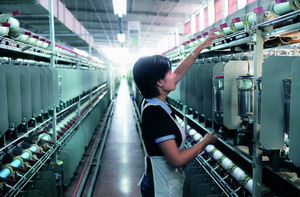Innovation: China's new frontier
Updated: 2011-08-23 16:26
By Chua Wee Phong (Sphere Exhibits)
|
|||||||||||
In November 2010, the State Intellectual Property Office of China outlined broad economic objectives and specific targets to be attained by 2015 through the use of new patents. The document, titled "National Patent Development Strategy (2011-2020)" revealed China's intention to power the development of its economy not through low-cost manufacturing, as it had in the past, but through the use of a new tool – innovation.
This is not a new strategy. At the recent ASEAN Regional Entrepreneurship Summit, US Secretary of State Hilary Clinton pinpointed the innovation and creativity of young entrepreneurs in Indonesia can help the government solve the problem of providing jobs to the 75 million Indonesians currently under the age of 18 . What makes the notion of innovation as an economic lever interesting is that it represents a substantial change in traditional Chinese economic planning.
Only ten years ago, Asia was the world's hinterland, merely a secondary market to North America and Europe. The rise of the twin powerhouses of China and India, as well as the explosive growth of other developing economies has brought renewed attention to the region. Asia is the hub of new technological developments like the focus on cloud technology, driven by the changing face of the Internet and the rapid uptake of mobile phones in Asia. Businesses in Asia, particularly technology businesses, are reaping the benefits of Asian receptiveness to technology and early adopter mindset, particularly in countries like Korea, Japan and Singapore.
For China to target innovation is a great step in a very different direction, for a country whose greatest strength was once its ability to manufacture goods cheaper than any other. And this will be a great shift – there were 300 thousand patent filings in China in 2009, but the new plan calls for this number to rise to 2 million per year by 2015 . China's recent patent filings in the United States also match this strategy for national development, in fields that China has declared as priorities, including solar and wind energy, information technology and telecommunications, and battery and manufacturing technologies for automobiles.
Other commentators have also noted this shift in China's strategy: in its August report titled "Patented in China: The Present and Future State of Innovation in China", ThomsonReuters' Eve Y. Zhou and Bob Stembridge concluded that "an epic industrial revolution has brought China to its current state of development, but it will be China's intellectual revolution that will carry it forward".
But will pressuring its people to create more patents be enough? Forbes' Bill Fischer describes the limitations of the innovation strategy, saying that a nation's firms must not only innovate, they must capture the economic value of innovation. That task includes creating the infrastructure to support innovation, as well as enabling companies (including both startups and established enterprises) to research, develop, and bring viable innovations to market.
Not an easy task, when China is located amidst a raft of other countries who are also banking on innovation. Take Thailand, not traditionally known for its computer science wizards, but where the enterprise applications market grew at 13.7 percent year on year in 2010. This is following 20.6 percent growth in 2009 according to IDC's Asia/Pacific Semiannual Enterprise Applications Tracker. At this rate, the enterprise applications market in Thailand is expected to be worth US$187 million by 2015, assuming a five-year compound annual growth rate of 12.5 percent. With an enviable 15percent market share, Thailand is the third largest market for enterprise applications in ASEAN, behind Singapore and Malaysia.
It is realising the value of innovation that will be China's greatest challenge, as it races to take advantage of the massive innovation potential in Asia. Creating an entrepreneurial culture could be a substantial challenge, but China has faced such challenges before. It took only two decades for China to go from being a poor economy to the manufacturing giant that it is today, and now, only a decade since, China is poised to reinvent itself yet again. The problem may not simply be one of incentivizing the creation of new products and services, but of making the right connections. Startups and other innovators will need to identify venues and opportunities to show off their ideas, in the hopes of attracting sufficient funding to help mature those ideas and bring them to a market-ready state.
The world is already looking towards Asia for the next big thing. Dell announced in July that it was opening a Singapore Solution Center, its first in of four such facilities planned for Asia, and part of twelve solution centers that will be built globally. These Centers will serve as showcases for Dell's technologies, and will help enterprises to test-bed new concepts. Other companies are bound to follow suit, bringing their resources to the region. This, naturally, represents a major opportunity for China, whose young companies can do a great deal to attract partnerships and investment, since venture capitalists and investors, in particular are shopping around to find the right projects to back. These new entrants will have to find a venue where they can be exposed to new ideas, to evaluate and decide which ones are worth the investment.
Finding occasions where entrepreneurship and investment cross paths can be difficult but fortunately there are ways and means to bring the two together. Trade shows, industry roundtables, specialist conferences, and other events organized specially by industry associations and other bodies are all excellent opportunities. These venues let startups meet and greet peers and other stakeholders, as well as build a network of contacts.
Then there is DEMO, a one of a kind platform for technology, where companies are given six minutes on stage to demonstrate their world-changing innovations, without the use of presentations or PowerPoint slides, and which also includes pavilions where entrepreneurs can present their wares to interested parties. As a specialised venue for the sharing of ideas, DEMO is the perfect starting point for China's young startups looking to make their way to market.
To make the best use of the talent and potential of its innovators and entrepreneurs, China's business minds are surely looking for some way to make the connection, to attract the venture capital that will be crucial to further development. This is the next challenge: making the connection between the ideas and the investment. For China, this change of direction will involve a great deal of internal adjustment, but it can be one that will pay off in the long run. It is innovation, after all, that propelled the American economy to its great heights, a feat that Chinese entrepreneurs may match or even outdo. Innovation is the new frontier for China, one that will need both creative minds and considered investment to realise the potential economic value for China's ongoing growth and development.













